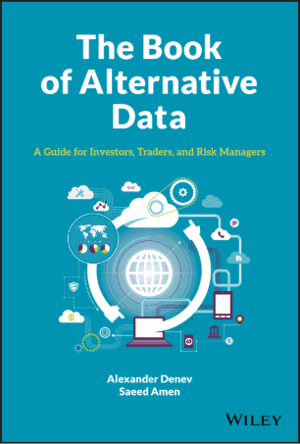
© 2020, Wiley
There is a pre-deposition by the data science community, which gave birth to the big-data era, to apply the latest and greatest machine learning methods in a horse race, claim victory, and go home. A plug-and-chug approach to data modeling does not work on financial data, no matter how BIG the data or how ‘feature engineered’ it is. By recruiting data scientists into the buy-side industry, it has effectively tried to run before it could walk.
The authors set out to put buy-side quantitative research on the right trajectory - understanding alternative data in a more comprehensive way is the first step towards developing trading strategies based on it. Both authors are veterans in buy-side quantitative research and strategy, with broad exposure to asset managers and hedge funds across many asset classes.
The book is separated into two parts, the first covering fundamentals and best practices in using alt-data for investing and while there is reference to cutting edge datasets and machine learning methodologies, the focus is more conceptual. The first part is accessible to anyone with an interest in institutional investing, not necessarily quants. In fact, it might serve as a course textbook for MS in Finance programs in business schools or an MBA program with a finance specialization. The second part is oriented more towards a quant researcher and, while gentle on the technicals, is setting out best practices for pre-processing and modeling with alt-data.
Some of the highlights include the focus on factor investing and a clear discussion of why alternative data might provide value to this approach. Incidentally, the chapter on factor investing is a must-read as a rounded introduction to factor modeling in its own right. Part II covers many useful examples which not only serve to illustrate many of the key concepts in this book, but also chart out many of the obstacles and pitfalls in using alt-data without getting lost in technical details. Examples include techniques for handling missing data and outliers, and modeling automotive fundamental data with Gaussian Processes.
There is a significant gap in the literature between asset pricing frameworks (Cochrane Citation2001), many of which were devised before the advent of big data, and the modern know-how needed to successfully adopt alt-data. This book does not provide a formulaic approach, but rather lays the conceptual groundwork for practitioners to be able navigate this complex and growing area. There are few books which are able to capture the wider context of quant modeling applications without being too vague, ambiguous, and self-referential, and the authors do an excellent job of keeping the narrative on point and exceptionally clear. In my view, the book is especially useful for quants that have less buy-side finance experience and are looking to gain a more mature perspective on how to reason about alt-data in investing. In style and objective (although very different in content), the book reminds me of ‘Blueprint to a billion’, which has become the bible for analysts in venture capital and private equity.
My final comment is on scope and technical depth. This is a difficult topic to write about, not least because there is no universal definition of alternative data, and even if there were, it would quickly evolve. Moreover, in taking a more managerial view on quantitative research with alt-data, the book instantly falls victim to criticism that it’s not sufficiently rigorous and technical in exposition. There are a lot of unknown unknowns in investing with alt-data and simply turning some of those into known unknowns, already makes this a valuable read from a risk management perspective. Indeed, in my view, the book offers a cautionary tale for data science purists siloed in an engineering mindset, who might dismiss pages light or void of equations or source code. If only data science Ph.Ds running Zillow’s algorithmic market-making in housing had read this book, Zillow might have avoided failure.
Additional information
Notes on contributors
Matthew Dixon
Matthew Dixon is Risk's Magazine's 2022 Buy-side Quant of the Year and the author of Machine Learning in Finance: From Theory to Practice. He holds a PhD in Applied Math from Imperial College.
References
- Cochrane, J. H., Asset Pricing, 2001 (Princeton University Press: Princeton).
